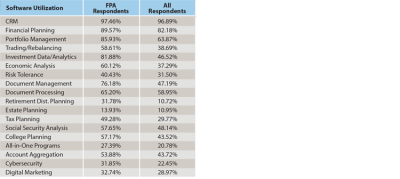Journal of Financial Planning: August 2022
Bob Veres is a former columnist for the Journal of Financial Planning, former editor of Financial Planning magazine, and is a recipient of FPA’s Heart of Financial Planning award. He publishes the Inside Information service for financial planners. He can be reached at www.bobveres.com.
NOTE: Click on the image below for a PDF version
Every year, I coproduce a report with Joel Bruckenstein of T3 that details the responses to an annual software survey of advisers, who are asked to rate the programs and solutions in their own office’s fintech stack. The report includes market share numbers and user rankings in 35 different software categories, ranging from the most popular (CRM, used by 96.89 percent of the offices we surveyed, financial planning at 82.18 percent, and portfolio management at 63.87 percent) down to fairly niche categories like customized billing and payment solutions (11.01 percent) and automated cash management (4.27 percent).
In this year’s “T3/Inside Information Software Survey,” we provide aggregate user ratings for each category, and for the market shares and user ratings, we include the previous year’s numbers for comparison purposes. In all, 4,495 advisers completed the 2022 version, which means we have a robust sample to report on.
New this year, we asked respondents to tell us what professional organizations they belong to. This offered us a number of surprises, including the fact that about a third (32.41 percent) of the respondents in this wide-ranging pool of advisers are FPA members, but also that only 45.21 percent of the respondents belong to any professional organization. The association community as a whole has some work to do to bring the other more-than-half of advisers into the professional association fold.
Our data indicates that 58.27 percent of FPA member respondents are fee-only, compared with 37.13 percent who are dually registered, and 4.60 percent who are wirehouse members. More than half of the FPA members in our survey have more than 20 years of experience, compared with 23.95 percent with 11–20 years in the business, 9.68 percent with 6–10 years of experience, and 11.32 percent are relative newbies, with 1–5 years in the advisory space.
Our new association data also allows us to compare the survey results from one organization to another and see whether there are fintech-specific cultural differences among the various professional cohorts. It’s probably not surprising that AICPA PFP Section members were most likely to use tax planning software (90.81 percent), compared with about half of FPA members and fewer than 30 percent of the sample as a whole. We found it a bit surprising to see that only 40.43 percent of FPA members reporting using one of the client risk tolerance assessment tools. More FPA members were using investment data and analytics solutions (think: Morningstar Advisor and YCharts) than advisers who reported a NAPFA or AICPA membership, but fewer than members of the Investments & Wealth Institute (93.22 percent).
Another interesting detail from the aggregate market share numbers is that the people who belong to FPA or other membership/professional organizations tend to be much more likely to use financial planning software than advisers who don’t report any association membership. The utilization rates across the membership organization spectrum were consistently around 90 percent or above, while the total response was (as mentioned earlier) a somewhat disappointing 82.18 percent. One might infer from this a higher quality of planning analysis and service from people who have a membership certificate hanging on their office wall.
Market Share, User Ratings
If we turn to the category rankings, we find with no great surprise that Redtail, now a part of the Orion platform, enjoyed the highest market share in the CRM category and also sported a high average user rating (58.84 percent and 8.17, respectively; 53.80 percent and 8.16 for FPA members), followed by Wealthbox (9.05 percent, 7.90 user rating). Tamarac (4.98 percent; 7.25) and Salesforce Financial Service Cloud (4.63 percent; 7.93) failed to breach the 5 percent market share threshold. I should note here that any rating above 7.0 in our surveys over the years represents a high degree of brand loyalty, so Redtail’s above-8.0 rating should be considered extraordinary.

As mentioned earlier, FPA members were far more likely to use financial planning software than our sample average, but their preferences tended to be similar to the respondents generally. From a market share standpoint, the planning solutions represent a three-horse race: MoneyGuidePro Elite (32.79 percent of the total sample, 8.08 user rating, compared with FPA members’ 31.60 percent and 8.26 rating) nosed out eMoney Pro (total sample: 28.59 percent; 8.13. FPA: 30.23 percent; 8.20), and RightCapital (11.59 percent and 8.14 for the total sample; 12.17 percent and 8.00 among FPA members). The Big Three finished well ahead of Orion Financial Planning (4.45 percent overall market share) and AssetMap (4.07 percent).
The most interesting statistic was how many advisers use more than one of these solutions. Over 12 percent of MoneyGuidePro Elite users are also using either eMoney Pro or RightCapital. Thirteen percent of eMoney Pro users are using either MoneyGuidePro Elite or RightCapital, and 15.55 percent of RightCapital users are also using either MoneyGuidePro Elite or eMoney Pro. (No survey participant, however, reported using all three.)
The portfolio management / reporting tools category, in terms of market share, was the opposite of the CRM rankings; instead of one program dominating the rankings, we identified four programs with roughly equal numbers of users, and several others with competitive market share. Albridge, a solution popular in the broker-dealer world, led the rankings with a 17.06 percent overall market share and a 7.64 average user rating, followed by Orion Adviser Services (14.35 percent; 7.86), Morningstar Office (10.61 percent; 7.67), and Tamarac (9.54 percent; 7.78). Black Diamond (5.94 percent; 7.92), Advyzon (3.80 percent; 8.49), and SEI (3.29 percent; 7.90) were competitive as well.
FPA members apparently disagreed with this hierarchy; their most popular solution was Orion (20.61 percent of FPA respondents and a higher 8.01 user rating), followed by Albridge (17.17 percent; 7.60), Tamarac (17.71 percent; 7.91), and Morningstar Office (11.60 percent; 7.55). Advyzon is far more popular with the FPA community than it is with the general population of advisers; it earned a 7.14 percent market share among FPA respondents.
While financial planning software covers a lot of the basics in a client’s financial life, there are specialized areas of investigation which usually require more specialized software—and here we begin to see some of the gaps in the advice that planning clients receive. Just 10.72 percent of the respondents to our survey are using any of the specialized retirement distribution planning tools, which offer the ability to model various tax-aware decumulation strategies for retirement portfolios. (Market share leader: Income Solver, with just 2.58 percent market share.) Roughly the same percentage of advisers (10.95 percent) reported using any of the estate planning software solutions (MoneyGuidePro’s new Wealth Studios module was the runaway leader, used by just 6.18 percent of adviser respondents), and fewer than a third (29.77 percent overall) use one of the tax planning programs available on the market. The market share leader, by a wide margin, was Holistiplan, at 17.95 percent of the total respondents, with a remarkable 8.93 user rating.
Meanwhile, fewer than half of the respondents (48.14 percent) are availing themselves of one of the Social Security analysis tools, and the majority of those are relying on the built-in capabilities of MoneyGuidePro or RightCapital, or publicly available tools from BlackRock and Nationwide.
FPA members, however, appear to be more comprehensive in their advice/analysis toolkits; 31.78 percent are using one of the retirement distribution planning solutions, 13.93 percent use an estate planning program, and 49.28 percent have one of the tax planning programs available to provide analysis to their clients.
Digital Marketing: The Haves and the Have-Nots
Very few of the software categories saw a market share decline from 2021 to 2022, and fewer still saw their aggregate user rating drop from one year to the next. But the digital marketing tools experienced declines in both areas, albeit incrementally (31.21 percent down to 28.97 percent and from 7.12 to 6.98).
But the decline was not the big story in that category. When we looked more closely at the survey data, we discovered that fewer than 30 percent of the advisory firm respondents are venturing into this digital space, while the majority of the others are on the sidelines—creating a potentially disruptive distinction between digital marketing haves and have-nots.
The market share leader is FMG Suite, now rebranded as FMG, which includes Marketing Library and Twenty Over Ten’s Lead Pilot digital marketing platform (16.13 percent market share and a 7.89 average rating), followed by Broadridge, which offers the Forefield content library and the AdvisorStream digital marketing platform (7.88 percent; 7.28), and Snappy Kraken, which is a turnkey digital marketing solution (4.58 percent; 6.82).
The overlap was substantial. Of the advisers who said they were using FMG, 21.57 percent were also using either Broadridge or Snappy Kraken. Nearly 37 percent of Broadridge users are also using either FMG or Snappy Kraken, while 35.89 percent of Snappy Kraken users are also using either Broadridge or FMG. And a decent number of advisers—more than 10 percent of the firms that utilize at least one of the digital marketing solutions—are subscribed to all three.
Missed Opportunities and Unmitigated Risk
What else surprised us? Only 38.69 percent of advisers are using one of the trading/rebalancing tools we listed (market share leaders: iRebal at 9.03 percent of the respondents, Tamarac at 8.63 percent, and Orion at 7.92 percent). Anybody who has used a spreadsheet to rebalance client accounts by hand will tell you that there will inevitably be a large discrepancy between the date, and price, of the first rebalance to the last, not to mention the staff time required to perform this task portfolio-by-portfolio, household-by-household. (In some cases, the market will have shifted back before the task is fully completed.) Few other categories would match the efficiency gains of this category, which makes you wonder why every adviser firm isn’t availing itself of one of the tools.
But the real head-smacker was the cybersecurity category, where just 22.45 percent of advisers reported using one of the 10 services we listed. This is up slightly from 18.71 percent in the previous survey. The category leader, Smarsh Entreda Unify (12.48 percent of the respondents) posted an excellent 8.16 user rating, and the excellent user rating of the whole category (7.79) suggests that those who do use these programs are happy with them.
Our conclusion here is that many advisory firm leaders haven’t yet internalized the fact that their client data represents a rich target to the most sophisticated cyberthieves who are probing their defenses. We suspect that if we had listed as a survey option, “Local IT Guy and Some Antivirus Software,” that would have been the runaway market share leader in this important, overlooked category.
The “T3/Inside Information Software Survey” provides a window into the remarkably rich array of fintech solutions in today’s adviser ecosystem, and can serve as a guidebook to any advisory firm’s next software buying decision. The user ratings offer a way to identify solutions which, even if they are not market share leaders, are doing a great job for their users; survey readers who save the report as a buyer’s guide would do well to look beyond the top of the market share list and consider one or more of the up-and-coming solutions that could be added to their tech stacks—to serve their own office efficiency or to better serve their clients.
